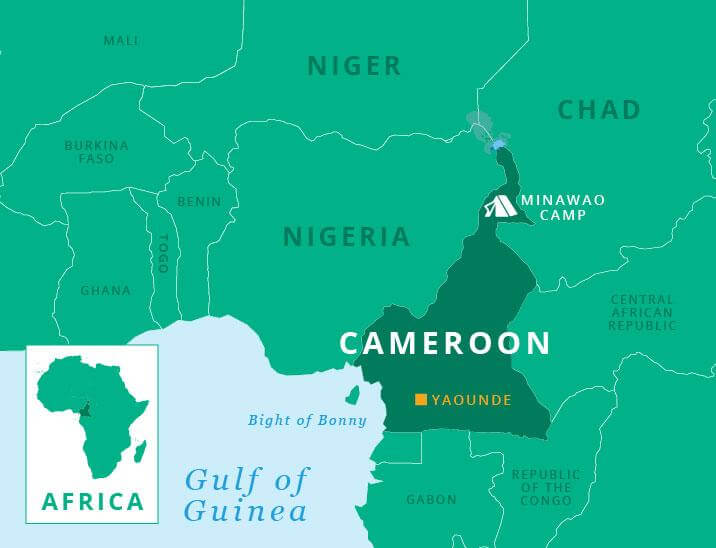Just 40 miles east of the Nigerian border lies Minawao camp – a dusty, sprawling refugee camp in the extreme north of Cameroon.
It is officially home to around 75,000 refugees, but families in the camps say that the number is much higher. Families have come here from Nigeria after escaping Boko Haram.
They might have escaped the attacks, but their loved ones have been killed, their homes have been torched and their livelihoods lost.
We have been working in Minawao camp since 2015. Tents and other items like solar lights, ground sheets, mosquito nets and hygiene kits, allow families to start paving the road to recovery.
We have also provided shelter to families outside of the camp, who have been forced from their homes due to Boko Haram violence, climatic changes or economic pressures.
Where is Cameroon?

Cameroon shares borders with six countries. It is bordered by Nigeria, Chad, the Central African Republic, Equatorial Guinea, Gabon and the Republic of Congo.
Minawao Camp lies in the extreme north of Cameroon, close to the Nigerian border.
Cameroon is an incredibly diverse place, with over 200 different languages and one of the highest literacy rates in Africa. But when Boko Haram led an insurgency in Nigeria in 2009, Cameroon was affected as violence and displacement spread across the border.
Today the crisis has become more complex, with extreme poverty, underdevelopment and climate change adding to the violence that has forced millions of people from their homes. Millions are in extreme hardship and dependent on humanitarian aid to survive.
Who is Boko Harem?
Boko Haram is an extremist militant group that opposes western education and influence in Nigeria.
The terrorist organisation has raged violent conflict in Nigeria since 2009, which has spread to neighbouring countries of Chad, Cameroon and Niger.
As Boko Haram has occupied territory, farmers and fishermen can no longer freely access what is left of the lake and lands.
Today, Boko Haram continue mass atrocities on villages – looting, killing, abducting women and children and conscripting men and boys into their army.
The world’s media took a stand in 2014 when 276 Chibok girls were kidnapped in Nigeria. But the atrocities have continued since then, seemingly going unnoticed.
One of the worst examples of Boko Haram terror and abuse is the use of children, mostly girls, as ‘human bombs’. Young girls are used as suicide bombers and have explosives strapped to their bodies.
The words ‘Boko Haram’ roughly translate to ‘western education is a sin’ and thousands of schools have been attacked, looted and burned. Over 1,000 children have been abducted and thousands of teachers killed.
But Boko Haram and the surrounding military offensive is just one of the driving factors in the Lake Chad Basin forcing people to flee their homes. Extreme poverty, underdevelopment and climate change are also at play in this forgotten crisis.
HOW IS SHELTERBOX HELPING?
We’ve supported over 100,000 people in Cameroon so far.
Working with our new partner, Public Concern, we are providing a range of emergency shelters and durable shelters.
Newly displaced people, both within Minawao Camp and outside the camp, will be supported with emergency tents and emergency shelters. We’ll also be providing household items like mosquito nets, sleeping mats, soap and kitchen sets.
People who have been displaced for longer need different support as they look to reconstruct their shelters into more durable structures.
To support them with this, we will be providing Shelter Packages with a range of construction materials including tarpaulin, wood, nails and cement.
We’ll also be supplying Community Tool Kits which include reusable items like hammers, nail pulls and brick molds. These will be shared between households.
These items can improve both the physical and emotional wellbeing of these families who have already been through so much.
